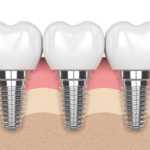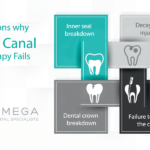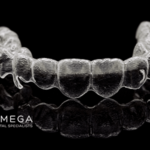What causes rotten teeth, Symptoms and Treatment Options
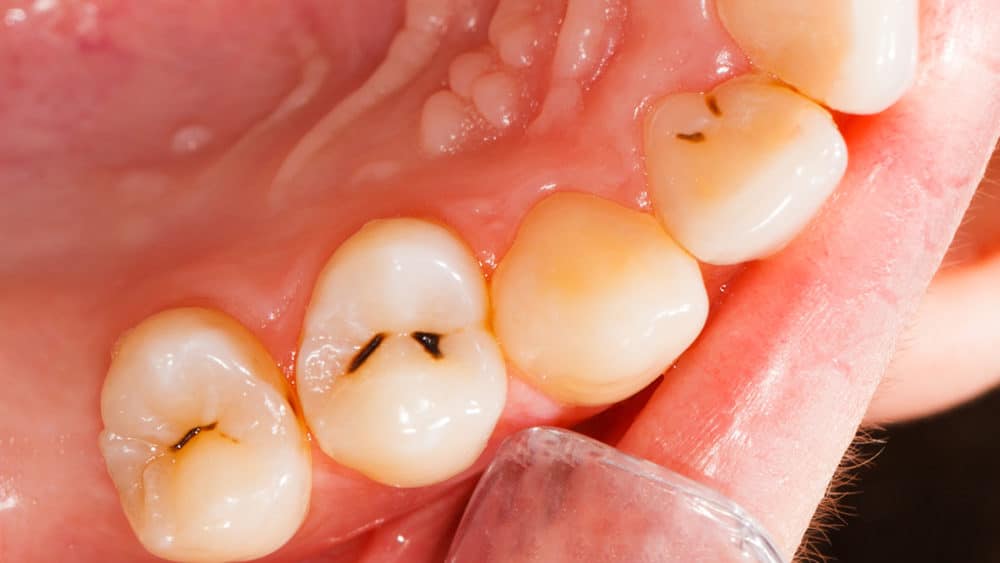
Rotten teeth happens when you don’t detect the cavity and a sever tooth decay happens. There is more to your teeth than just a spectacular smile. If you are suffering from a serious form of tooth decay known as Rotten Tooth, you can experience more than just a toothache. Your overall health can be affected. If you have bad teeth, there are a number of options for saving a rotting tooth.
If you suspect you might be suffering from this serious condition, call Omega Dental Specialists, the best dentist in town, for an evaluation today. You will be amazed at the difference in your rotted teeth before and after treatment.
Table of Contents
What Happens to a Rotten Tooth?
A rotten tooth is one that is severely decayed. The decay, also known as dental caries or a tooth cavity, begins with the breakdown of the tooth enamel. Plaque builds up and combines with bacteria to break down the enamel. Once the enamel has broken down, cavities develop. If you fail to treat your cavities, they will get worse. Dental caries is an open invitation to bacteria to further invade your teeth and beyond.
Dental caries does not discriminate. A tooth cavity can happen at any age. Baby bottle tooth decay is a breakdown of enamel caused by the sugar found in formula and extensive use of a baby bottle. The formula will pool around the teeth and combine with bacteria which accelerates breakdown in enamel. The condition is most common with a rotten back tooth or rotten bottom teeth. Thanks to a variety of available treatments, we can restore even those teeth you may believe to be permanently damaged.
What Causes Rotten Teeth?
Dental caries results from a combination of not taking care of your teeth, the foods you eat, and in some cases, drugs of abuse or even legally prescribed medications. Foods that are high in sugar or starch are known to aid in breaking down tooth enamel. If you consume a lot of sugary drinks, the deterioration of enamel is accelerated. The presence of naturally occurring bacteria also accelerates this process. The bacteria and food build up and cause an acid that attacks the enamel accelerating the breakdown.
Practicing good oral hygiene can slow the process of enamel deterioration and tooth decay. Brushing and flossing away the food following every meal takes away its opportunity to attack and break down your tooth enamel.
How do you know if you have a rotten tooth?
The first symptoms most people notice are sensitivity to hot and cold food and drinks. Sugary and sweets can cause similar sensitivity. You may feel pain when you bite into your food. When the level of decay progresses, toothaches become not only a regular event but more severe as time goes on. Bad breath that does not go away and having an unpleasant taste in your mouth are other common symptoms. You may experience swelling in the gums and in your face as the dental caries progress.
Visually, you might first notice discoloration as the enamel deteriorates followed by tiny holes in your teeth. You will also see dark spots as the decay becomes more apparent. As the decay gets worse, the toothaches will become unbearable, your teeth can crack, pieces of your teeth can break off, or a tooth can completely break at the gum line. You will start having trouble eating and may lose weight. It is possible you will lose important nutrients that are critical to your health. The symptoms of a rotten tooth will grow more severe as time goes by. You are more likely to notice this kind of symptom in a rotten back tooth or rotten bottom teeth. In comparison, rotten front teeth are relatively rare.
What are the Dangers of Rotten Teeth?
There are some significant dangers that can result from rotten teeth. Bacteria play a substantial role in tooth decay and rotten teeth. When bacteria penetrate the tooth, it can get into the gum tissue and cause an infection that can eventually work its way into the bloodstream. Infections can make you extremely ill. If they are not treated, the blood infections can turn into sepsis which, in a worst-case scenario, could kill you.
Symptoms that you may be experiencing a blood infection include severe fatigue, lack of energy, fever, nausea, vomiting, and diarrhea. If the infection develops into sepsis, you may become confused, experience hallucinations and ultimately lapse into a coma.
Tooth Decay Stages
There are three tooth decay stages. Early-stage decay is little more than an initial breakdown in the tooth enamel. There might be very tiny cavities, but early tooth decay stages can usually be reversed. Advanced tooth decay stages show significant cavities. At this stage, dental caries has gone further than just the enamel but have not yet reached the pulp of the tooth. Very advanced tooth decay stages show dental caries in the pulp of the tooth.
Your dentist will decide the level of treatment according to the level of decay. In addition, in most cases your dentists should be able to save the rotten tooth.
What to do for a Rotten Tooth
When putting together your plan for your rotten teeth treatment, your dentist will first consider the location of your tooth and the stage of the decay. They will also consider whether the tooth is a baby tooth or a permanent tooth. Throughout your life, your smile is not only your first impression but also your lasting impression. If your decay is on a front tooth, your dentist will take a different path towards restoration than when your decay is on a molar. No matter where your bad teeth are located, there are several options for saving a rotten tooth.
Decay that occurs on either your back teeth or your bottom teeth is treated with traditional fillings and crowns. It is more common for your back teeth to decay because they are harder to reach and may not get the care that your front teeth do when you brush and floss. No matter what stage of decay, you will notice a difference in your rotted teeth before and after treatment. With several options available, your rotten teeth do not need to be considered permanently damaged. The rotten teeth treatment options for each stage of decay are:
Early-Stage Treatment Options
Early-stage decay is a breakdown in enamel and perhaps a very small tooth cavity. At this stage, a simple fluoride treatment can reverse a tooth cavity and rebuild enamel. A fluoride treatment is not indicated if decay is already progressing to dark spots on the teeth or a steady case of bad breath. Early-stage decay may appear as more of a discoloration of the tooth. Regular hygiene appointments and daily oral care can keep your decay to a minimum when they can catch decay at the early stage.
Advanced Stage Treatment Options
If your tooth decay is in the advanced stage, your dentist can still easily restore the permanently damaged tooth. Cavities are visible to the naked eye at this stage of decay. Using a dental drill, the decayed areas are removed from the tooth. The empty spaces are then filled in with either porcelain, composite resin that is colored to match your tooth or an amalgam composed of various metals and porcelain. If the decay has weakened the tooth, your dentist will remove your natural crown and a customized replacement crown may be made to order. Crowns are made of either porcelain, gold, or a metal-porcelain combination. The custom crown will replace the natural crown on your tooth and will be cemented into place. It is not uncommon to have a rotten tooth under crown.
Very Advanced Stage Treatment Options
When decay reaches the inner pulp of your permanently damaged tooth, a root canal may be the last resort to save your tooth. Your dentist will need to remove the affected pulp and replace it with filling material. It is common practice to place medicine in the tooth beneath the filling material to fight any remaining bacteria. If the tooth is decayed beyond restoration, your dentist will need to extract the tooth. X-rays are used t0o confirm the need for root canals.
While the treatments listed above may well be indicated for rotten front teeth as well, especially when the decay is early stage, there are different methods for how do dentists fix rotten front teeth. No matter what the problem, ranging from tiny holes to the need for a full crown, in most cases your dentist can save the rotten tooth.
See Also: Cost of Root canal treatment
How Do Dentists Fix Rotten Front Teeth?
To give you the best smile possible, restoring rotten front teeth is different from your back teeth. Your front teeth are thinner than your back teeth, have fewer roots, and have different requirements when tiny holes or a tooth cavity is present. These treatment options are also appropriate if you have chipped or broken your front teeth. Your dentist can choose to put veneers over rotten teeth or putting your rotten tooth under crown. Whichever option you choose, the difference in your rotten teeth before and after treatment will give you back your smile.
Crowns for Front Teeth
When a crown is placed on a front tooth, it covers the entire tooth. Your dentist will need pictures and impressions so that color, size and shape match your other teeth. The dentist will then file down your tooth and then take a second impression. Photos and impressions are then sent to the laboratory where a perfect custom crown is created. Your new crown will be cemented into place and your dazzling smile will be restored. One benefit of having a rotten tooth under crown is its stabilizing quality. If your decay was very advanced, the crown will strengthen your tooth.
Veneers
Your dentist may be able to put veneers over rotten teeth. Veneers are ideal for situations where the decay is located on the front of your tooth, or if your teeth are chipped or broken. Veneers are ultrathin and are affixed to the front of your tooth. Your teeth are prepared for the veneer by being filed down to ensure that the veneer will fit right. In order to maintain the symmetry of your smile, many patients choose to place veneers on the teeth next to the one being repaired. Veneers are also popular for purely cosmetic purposes.
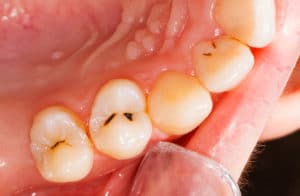 Preventing Rotten Teeth
Preventing Rotten Teeth
Decay and rotten teeth can be prevented through the practice of good oral care and regular appointments with a dental hygienist. Prevention practices are different in adults and children.
Preventing Rotten Teeth in Children
Tooth decay can begin when children are just babies, and prevention needs to begin when the first baby teeth appear. Baby bottle decay is the result of breast milk and formula pooling in your baby’s mouth. Early decay in baby teeth can be prevented by not putting the baby down with his or her bottle. At these early ages, you can gently clean their baby teeth with your finger. As they get older, you can use a toothbrush as you teach them to brush their own teeth. You should follow these basic guidelines to instill good oral hygiene practices in your children:
- Teach your children at a young age to brush and floss at least twice a day.
- Feed your child a healthy diet with lots of fruit and vegetables. Avoid feeding them dry cereals, cookies, cakes and sugary drinks as these foods tend to stick to tooth enamel.
- Discourage frequent snacking.
- Regular dental checkups and cleaning appointments can identify enamel breakdown or tiny holes before they get worse.
Preventing Rotten Teeth in Adults
By the time that you reach adulthood, you should have good oral hygiene skills. Good oral hygiene is even more important for adults. Permanent teeth are stronger than baby teeth, but they are also your last natural set. To prevent tooth decay in adults:
- Brush and floss after every meal using fluoride toothpaste.
- Drink lots of water and unsweetened drinks.
- Rinse your mouth with tap water. Since tap water is fluorinated, it is an extra source of fluoride.
- Eat healthy foods. Fruits and vegetables are tooth-friendly foods.
- Avoid frequent snacking. Snack foods will stick to your teeth and can accelerate the breakdown of enamel.
- Ask your dentist about fluoride treatments or rinses.
- Schedule regular checkups and teeth cleaning with your dentist.
Failure to Treat Rotten Teeth
If you fail to have rotten teeth treated, you subject yourself to possible dangers to your health. Allowing your teeth to rot will lead to toothaches, broken teeth, chipped teeth and eventual loss of those teeth. You will be unable to eat a lot of solid foods and eating will become a painful experience. Rotten teeth can also lead to:
- Lowered immunity. Bacteria and infections from rotten teeth can lead to a decrease in your body’s immune response. When your immunity is off, you are more susceptible to catching colds, the flu, and other viral and bacterial infections. Other signs of decreased immunity can be a mild trembling of your hands.
- Reduced social interactions. Bad teeth lead to decreased social interactions. When your teeth are rotten, you are less inclined to smile. You will feel more self-conscious and less likely to maintain social relationships. Depression and anxiety can occur.
- Gum disease. Rotten teeth can lead to gum disease. Gum disease can lead to your teeth falling out.
- Diminished palate. Over time, rotten teeth will lead to an inability to enjoy your favorite foods. Some foods will feel like they are burning you. As you begin to lose your teeth, you will not be able to eat a lot of the foods you enjoy. Your sense of taste might even become reduced over time.
- Blood infections and sepsis. Failing to treat your rotten teeth can lead to bacteria entering and infecting your bloodstream. Untreated, blood infections can lead to sepsis which can ultimately lead to death.
Cost of Rotten Teeth
Advanced dental treatments can be costly. Every patient and every situation is different. There are a number of factors that need to be considered for each treatment option:
Fillings Cost
Fillings vary in price based on the tooth being filled, the amount of damage being restored, the number of teeth being filled, and the material used to fill each tooth. Filling cost ranges for each of the filling materials are:
- Amalgam fillings costs range $210 to $400
- Composite fillings costs range $270 to $450
- Silver fillings costs range $370 to $1,100
- Ceramic fillings costs range $300 to #4,500
- Gold fillings costs range $500 to $4,500
Root Canal Cost
Each tooth has a minimum of a single root for front teeth to several roots for molars. The cost of a root canal depends on the location of the tooth, the number of roots, number of appointments and other factors. Each root canal will be evaluated as to the needs of the patient. In general, root canals costs range from $1,000 to $2,000 per tooth.
Crown Cost
The cost of a crown depends on the type of crown and the size of the crown. Crown costs range from $1,100 to $1,500.
Veneers Cost
The costs of veneers are different for each patient. There are considerations as to the number of appointments needed, the material your veneers will be made from and other factors. In general, Veneers range in costs from $800 to $2,000 per tooth.
Insurance Coverage
If you have dental insurance, most of the services required to treat rotten teeth are covered. Your dental office can review your insurance, the level of coverage and your copays.
Your Houston Texas Dentists
In Houston Texas, you have access to the best dentist in town when you go to Omega Dental Specialists. We offer you access to all of the dental specialties in one location. Our dental staff includes specialists in general dentistry, endodontics, periodontics, orthodontics and oral surgery. Make your appointment today and let your rotten tooth problem become a thing of the past.

